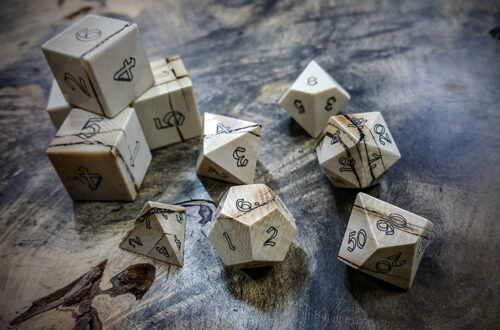
Coldforged: A Brief History of Tysis 9 – The Fourth Age Part 2
Each Thursday this year, I focus on a different aspect of the world I’ve created and played D&D in for over 20 years, in the hopes of honing the ideas and cementing enough in place to settle the world in my own mind. This week I’ll continue to pull all the histories together and work towards the current time, starting at the dawn of the 4th Age, the current time
Tyndaria Fragments
Following the defeat of Moduru for the second time and the end of the occupation of Tyrndall by Modurus armies, the noble’s houses of Tyrndall grew dissatisfied with Wanderer’s rule, especially house Silentknife, whose lands wanderer had knowingly let suffer in order to attempt to mitigate damage elsewhere in the kingdom. House Silentknife rebelled just over a year after the end of the war, throwing out tax collectors and executing an entire garrison of Blades sent to enforce the king’s will.
House Silentknife rebelled alone, as none of the other houses would dare join with the memory of the previous rebellion so fresh in their minds. Though none would have guessed it at the time, the rebellion lasted for six and a half years, until Wanderer pulled out the Blades and exited the region, leaving it to its own devices. Just a few months later, Wanderer, his wife Messana and their twin newborn children vanished from the castle without a trace. They had clearly packed clothes and supplies for the journey and were not kidnapped or slain, but a kingdom-wide search proved fruitless in its endeavor to locate the ruler.
Grady, Wanderers Second, declared himself Warden but was an inexperienced and incompetent political leader, thrust into his position unexpectedly. Quickly, the repercussions of the King vacating his throne were felt. Multiple families rebelled over the course of a few short weeks, and soon the Warden was engaged on multiple fronts in every direction. Thankfully, Grady was an expert tactician and a warrior of no short skill, and he was able to fend off, over the course of a decade, multiple invasions from rebellion Kingdoms. He was even, in two instances, able to defeat the rebels and bring them back into the fold. The rest of the rebellions succeeded in breaking away, though, as he was simply overmatched both with numerical forces and with supplies. Though able to keep control of what did not rebel, what was once a single Kingdom had, by the end of 654 AR, had broken into 11 different Kingdoms.
Wanderer’s return as king was a shock to the whole Tyndarian system. He revealed himself in the throne room and demanded to resume the Kingship, stating that the realm had fallen apart and suffered in his absence. The room was silent and no one objected as he ascended the dais, threw Grady bodily down the steps, and sentenced him to the dungeons for mismanagement of the Kingdom. To this day, Wanderer bides his time, consolidating power, gathering soldiers, and plotting to one day reconquer all of Tyndaria.
Nova Killbarum
As Moduru was destroyed and the armies vanished, Killbarans were left in a state of disaster and disarray. Their mages were slain, the colleges were abandoned or worse, and their capital city was destroyed, razed and salted.
This power vacuum left room for dozens of warlords to take control, each one a different method of control and power. Ogre overlords, hag covens, deceitful cannibals and immortal warlocks each strove for power against each other, imposing their rule on the populace, carving their domains out with blood and fire. In each town and region, the rules and laws varied with penalties ranging from exile to death. A few were not actively hostile seeking to keep the traditions of the Republic alive, while others sought to bring down all order and law, simply farming the population as food.
Territory was quickly claimed, tested, and defended. Violence was the currency of the Republic, and the cost to the populace was great, with villas and farmsteads being abandoned as the commoners fled to the cities for protection against the marauders. In these times, it was the strongest who survived and thrived. Conflict was a constant companion in Killbar, from the forest of Lev to the Great Swamp, with dozens of petty rulers springing up wherever they could locate a foothold.
For over 20 years, the warlords have fought against each other, and many have fallen, and more have risen. New domains are constantly claimed as leaders are slain by subordinates, overthrown by their populace, or simply destroyed by their adversaries. Recently The Imerian Peninsula has been claimed by Magus Numer Tyn(athrillmaithan), a petty Arcanist warlord who has declared the peninsula and his territory Nova Killbarum (New Killbar), declaring a new Killbarin empire, and states that he will retake all of the lands Killbar once claimed and put in place an empire grander and more powerful than the old that has fallen. Few believe him, but those fanatics who do have flocked to his city, Ephandrus, in hopes that their dreams can finally be realized.
The Death of Gods
In summer 650AR a cult of Tremid lured the god Marija bodily out of the Iron Marches with a terrible ritual. Once bodily on the world, the cult also corrupted the deific body and mind, turning it into a foul taint that could be passed to others. In his insanity, he called out challenges to the other gods, instigating fights and threatening to level the world. The other gods, not understanding their peril, sent their greatest warrior, Gestril, the god of storms. He, too, stepped bodily into the world, to engage his brother and convince him of his folly. A great battle ensued, one that shook the land and shattered mountains, but Marija was given vital power by the fell taint imbuing his body, and though it was difficult, he struck a mortal blow, and the corruption filled Gestril. Wisely, Gestril was able to sunder his own vessel to prevent the corruption from spreading but dealt himself a great blow in the process.
With his brother dead, Marija fled to the shattered mountaintop in a moment of clarity and shame. There, a group of iron-willed adventurers, emboldened by Gestrils sacrifice, met and defeated the corrupted god before it could return to the iron marches and turn the tide of the war.
Two gods lost their grip on the powers of the world that day, with both storms and animals going wild and uncontrolled across the world. The chaos lasted but a short time, however, and it is known that, though Marija is dead, Gestril rests and recovers, one day to return to the Iron Marches with the power of both gods.
The Wraithhold
In 656 AR, in a single moment across lands spanning from southern Lev, Killbar, The Toldiri Hills and Tyrndall, massive ziggurats violently erupted from the ground where they had been buried for centuries. Pouring out from these structures came both living and undead dwarves and humans, remnants of an alliance that had held sway here in ages past and had sunk away their cities to protect them from invasion. Now, as foretold by their prophecies, they rose again into the world to take back what is theirs.
The Wraithhold is ruled by immortal dwarves, both undead and living, who reside in these massive ziggurats. These fortresses require little in terms of sustenance or outside influence and emanate a vile putrescence that suffuses both land and creature giving them a horrific presence. With their attempt to resurrect the Scion of Earth and Ash, Gromulur, foiled, the Dwarven lords hold an uneasy truce, and some seek to assimilate the territory and power of their defeated brethren, stressing relationships of the remaining 21 Lords.
Each of these lords was a powerful being prior to the destruction of Modresto, and continues to be so after their resurrections. This new force on the land of Tysis is the cause of concern to their neighbors. Their emergence caused a number of small scale wars, with the Modresto forces overwhelming the surprised defenders, but since that time, the Modresto have not made any overtures of either war or peace, maintaining their lands and slaying any who enter.
The Great Plague
While other lands suffered their own great turmoil, the Kingdom of Lev was not spared their share. While they did not suffer great schisms, violent uprisings or outside conquest, they had a calamity all of their own that ripped through the population and left many of their cities and towns shattered.
Shortly after Moduru’s second war, within the confines of their realms and under the dictates of the Great Recall, the Levishans were experimenting with a method to prevent the unpermitted from entering their domain. Unwittingly released a virulent magical disease that ate away at the minds and the bodies of those fey that it came into contact with. Instead of creating a method to destroy intruders, they created death itself.
The infection spread swiftly, infecting fay across the Kingdom. The incubation period was fairly short, the matter of a day or so, which would be followed by a burning fever that also impelled the infected individual to perpetual movement and action. They would work, carve and pace as needed in a frenzy of activity. The infection would then reach its final stage where the victim would lash out at those nearby, first with curses and insults, but would quickly escalate to whatever was on hand, from fire pokers to greatswords.
What was surprising about the infection, beyond its violent temperament and destructive tendencies, was its ability to recognize others in the grips of the infection and refrain from attacking them, leading to the entire towns becoming infected and marching in mass against other towns.
The final and lasting effects of the plague are devastating, impacting the afflicted, their friends and families, and the entire culture of Lev, as once the plague passes if it does, and the individual recovers, they are never really themselves again, losing most of their sense of community, forgetting most everything from their former lives, embracing a more primitive and feral way of life, fading into the deep forest as packs of survivors that both roam the deep woodlands and instinctually hunting those who remain within civilizations embrace.
Little is known about the effects of the plague or how to stop it, and over the course of the last 16 years, it has slowly spread from the far north towards the south, where entire roving bands of infected fey have emerged to ravage both Killbaran and Modresto towns, only stopping once every individual was slain. It is suspected by Levishan scholars that if the infection spreads beyond the borders of Lev and to a Killbaran elf or gnome, it may never end.


